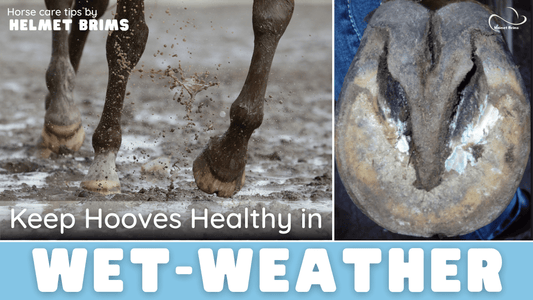🐴 How to Care for Your Horse’s Hooves in Wet Weather
Share

TL;DR😉 (too long; didn't read)
Wet conditions can quickly damage your horse’s hooves - leading to thrush, soreness, and softening. The fix? Daily cleaning, strategic drying, and protective treatments that stop excess moisture from becoming a problem.
Why Wet Weather Wreaks Havoc on Hooves
When hooves stay damp for too long, they lose strength and grip. Mud, puddles, and humid air soften the hoof wall and create the perfect breeding ground for thrush bacteria and fungi.
That means more abscesses, sore feet, and unhappy rides - especially for endurance or trail horses spending long hours outside.
🧰 Step-by-Step Hoof-Care Routine for Rainy Days
- Dry first. After every ride or turnout, towel off hooves completely.
- Seal and protect. Apply a quality hoof oil or sealant to block water and lock in strength.
- Check daily. Look for a strong odour, blackened frog, or crumbly areas - all early signs of thrush.
- Trim regularly. A tidy hoof drains better and sheds mud naturally.
- Rotate paddocks. Give your horse time on higher, well-drained ground whenever possible.
💡 Better Hoof Health Tips
* Pick out hooves every day, paying attention to the frog.
* Keep bedding clean and dry.
* Use mild thrush treatments or hydrogen-peroxide mixes (check with your vet).
* Support strong growth through nutrition - minerals and biotin matter.
🦠 How to Spot and Treat Thrush
Thrush shows up as a dark, foul-smelling discharge in the frog area.
Treatment:
- Clean the hoof thoroughly.
- Remove dead frog tissue.
- Apply a thrush-specific topical.
- Keep hooves dry until healed.
Consistency is key. Regular cleaning and dry footing stop it from coming back.
🌦 All-Weather Riding Insight
Rainy conditions test both rider and horse. A well-maintained hoof equals comfort and safety. Pair that with reliable sun-safe gear - like an Australian Made Helmet Brim - and you’re ready for every season, from downpours to heatwaves.
Helmet Brims designs and handcrafts UPF50+ sun-safe helmet visors for riders and cyclists worldwide. Each brim is lightweight, durable, and stays secure in wind and at speed - with free worldwide shipping.
✅ FAQs
How do I stop hooves softening in the rain?
Keep them dry when possible, apply protective oils, and avoid constant standing in mud.
What causes thrush?
Bacteria thrive in damp, dirty environments - cleaning and ventilation are your best prevention.
How often should I clean hooves in wet weather?
At least once daily, or more if conditions are muddy.
Does hoof oil really help?
Yes, it acts as a moisture barrier to prevent softening and cracking.
🌍 Why This Matters for Riders Everywhere
Wet-season hoof care isn’t just an Australian issue - riders in the US, UK, and Europe face similar challenges every year. The key is routine, awareness, and the right protective approach for both you and your horse.
Healthy hooves mean confident rides. And while you’re protecting your horse’s feet, don’t forget to protect yourself from the elements too - with durable, handcrafted Helmet Brims that keep you cool, comfortable, and covered wherever you ride.
👉 Explore the colour and size options here and get free worldwide shipping!
More horse care tips coming soon. Click here to read about DRY conditions and how to care for hooves.




